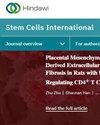Stimulated Human Umbilical Cord Mesenchymal Stem Cells Enhance the Osteogenesis and Cranial Bone Regeneration through IL-32 Mediated P38 Signaling Pathway
IF 3.3
3区 医学
Q2 CELL & TISSUE ENGINEERING
引用次数: 0
Abstract
Objective. Our previous study found that it could significantly increase the expression of IL32 after stimulating the human umbilical cord mesenchymal stem cells (S-HuMSCs). However, its role on the osteogenesis and cranial bone regeneration is still largely unknown. Here, we investigated the possible mechanism of this effect. Material and Methods. A series of experiments, including single-cell sequencing, flow cytometry, quantitative real-time polymerase chain reaction, and western blotting, were carried out to evaluate the characteristic and adipogenic–osteogenic differentiation potential of IL-32 overexpression HuMSCs (IL-32highHuMSCs) through mediating the P38 signaling pathway. Moreover, a rat skull bone defect model was established and treated by directly injecting the IL-32highHuMSCs to conduct its role on the cranial bone regeneration. Results. In total, it found that compared to HuMSCs, IL32 was significantly increased and promoted the osteogenic differentiation (lower expressions of PPARγ, Adiponectin, and C/EBPα, and increased expressions of RUNX2, ALP, BMP2, OPN, SP7, OCN, and DLX5) in the S-HuMSCs (). Meanwhile, the enhanced osteogenic differentiation of HuMSCs was recovered by IL-32 overexpression (IL-32highHuMSCs) through activating the P38 signaling pathway, like as the S-HuMSCs (). However, the osteogenic differentiation potential of IL-32highHuMSCs was significantly reversed by the P38 signaling pathway inhibitor SB203580 (). Additionally, the HuMSCs, S-HuMSCs, and IL-32highHuMSCs all presented adipogenic–osteogenic differentiation potential, with higher levels of CD73, CD90, and CD105, and lower CD14, CD34, and CD45 (). Furthermore, these findings were confirmed by the rat skull bone defect model, in which the cranial bone regeneration was more pronounced in the IL-32highHuMSCs treated group compared to those in the HuMSCs group, with higher expressions of RUNX2, ALP, BMP2, and DLX5 (). Conclusion. We have confirmed that S-HuMSCs can enhance the osteogenesis and cranial bone regeneration through promoting IL-32-mediated P38 signaling pathway, which is proved that IL-32 may be a therapeutic target, or a biomarker for the treatment of cranial bone injuries.受刺激的人脐带间充质干细胞通过 IL-32 介导的 P38 信号通路促进骨生成和颅骨再生
研究目的我们之前的研究发现,刺激人脐带间充质干细胞(S-HuMSCs)后可显著增加 IL32 的表达。然而,它对成骨和颅骨再生的作用仍然是未知的。在此,我们研究了这种作用的可能机制。材料与方法通过单细胞测序、流式细胞术、实时定量聚合酶链式反应和 Western 印迹等一系列实验,评估 IL-32 过表达 HuMSCs(IL-32highHuMSCs)通过介导 P38 信号通路的特征和成脂-成骨分化潜力。此外,还建立了大鼠颅骨缺损模型,并通过直接注射 IL-32highHuMSCs 治疗该模型,研究其对颅骨再生的作用。结果总之,研究发现与HuMSCs相比,IL32在S-HuMSCs中显著增加并促进成骨分化(PPARγ、Adiponectin和C/EBPα的表达降低,RUNX2、ALP、BMP2、OPN、SP7、OCN和DLX5的表达增加)。同时,与 S-HuMSCs 一样,通过激活 P38 信号通路,IL-32 过表达(IL-32highHuMSCs)可恢复 HuMSCs 增强的成骨分化能力()。然而,P38 信号通路抑制剂 SB203580 会显著逆转 IL-32highHuMSCs 的成骨分化潜能。此外,HuMSCs、S-HuMSCs 和 IL-32highHuMSCs 都具有成脂-成骨分化潜能,CD73、CD90 和 CD105 水平较高,CD14、CD34 和 CD45 水平较低()。此外,大鼠颅骨缺损模型也证实了这些发现,与 HuMSCs 组相比,IL-32highHuMSCs 处理组的颅骨再生更明显,RUNX2、ALP、BMP2 和 DLX5 的表达更高()。结论我们证实,S-HuMSCs 可通过促进 IL-32 介导的 P38 信号通路增强成骨和颅骨再生,这证明 IL-32 可能是治疗颅骨损伤的治疗靶点或生物标志物。
本文章由计算机程序翻译,如有差异,请以英文原文为准。
求助全文
约1分钟内获得全文
求助全文
来源期刊

Stem Cells International
CELL & TISSUE ENGINEERING-
CiteScore
8.10
自引率
2.30%
发文量
188
审稿时长
18 weeks
期刊介绍:
Stem Cells International is a peer-reviewed, Open Access journal that publishes original research articles, review articles, and clinical studies in all areas of stem cell biology and applications. The journal will consider basic, translational, and clinical research, including animal models and clinical trials.
Topics covered include, but are not limited to: embryonic stem cells; induced pluripotent stem cells; tissue-specific stem cells; stem cell differentiation; genetics and epigenetics; cancer stem cells; stem cell technologies; ethical, legal, and social issues.
 求助内容:
求助内容: 应助结果提醒方式:
应助结果提醒方式:


